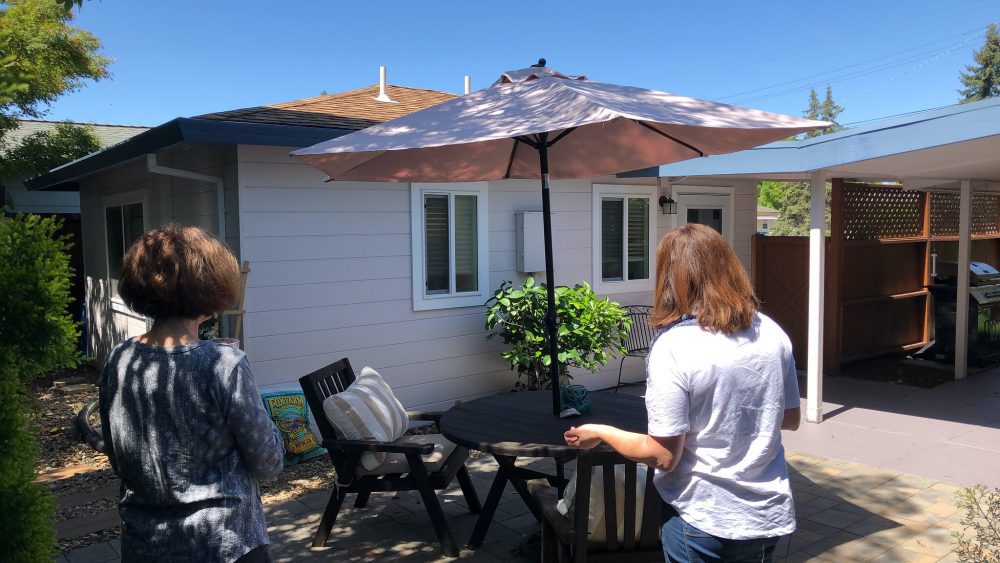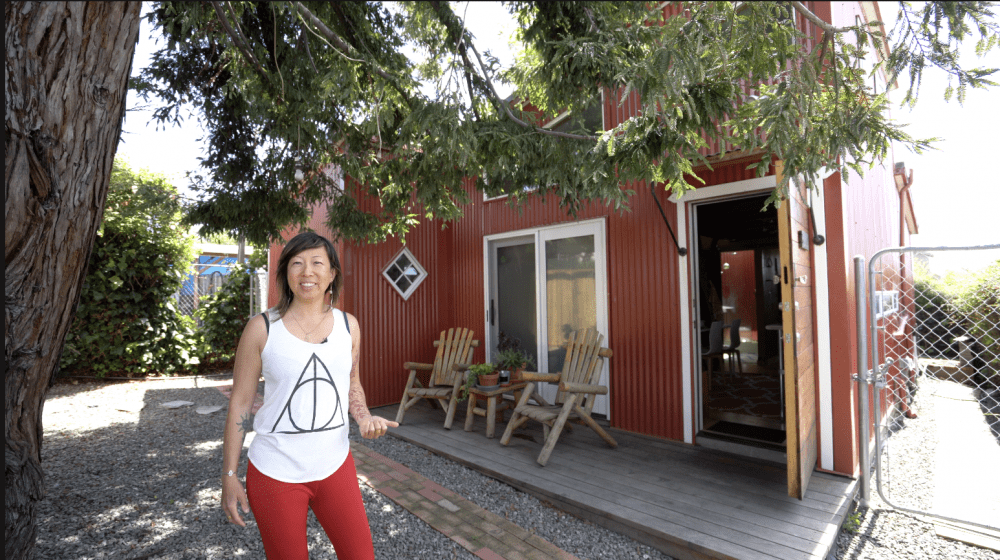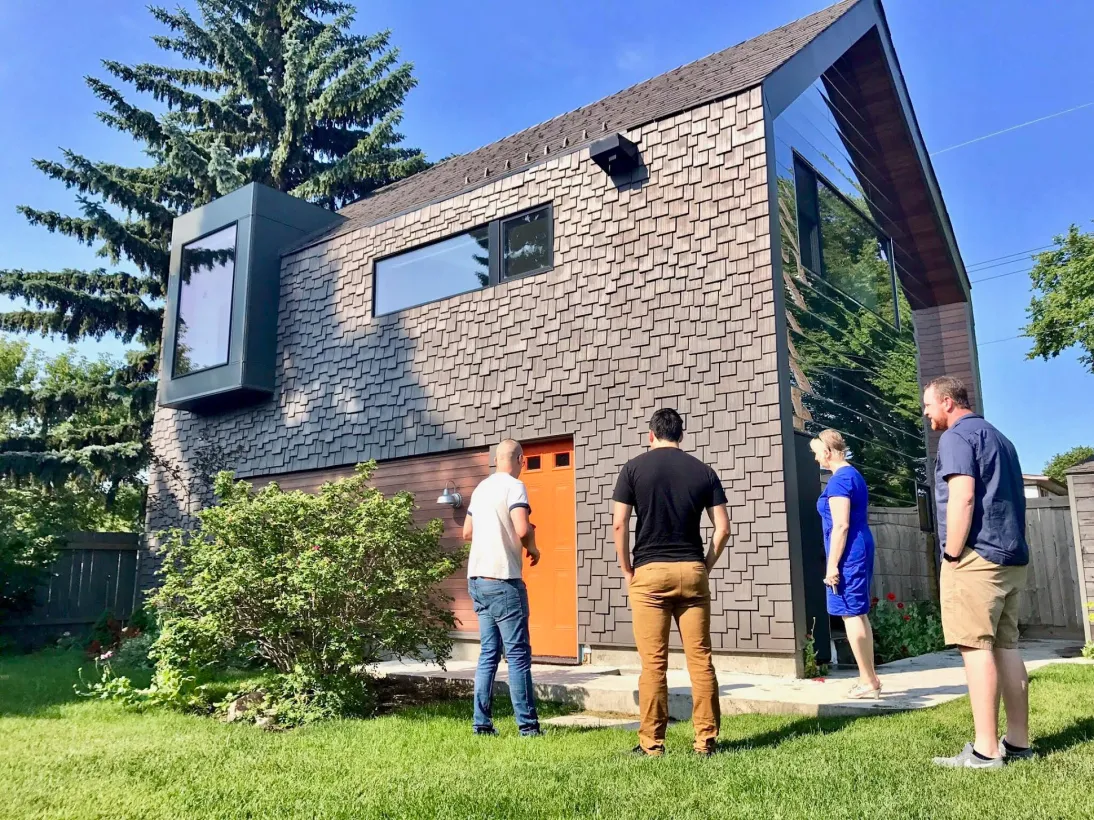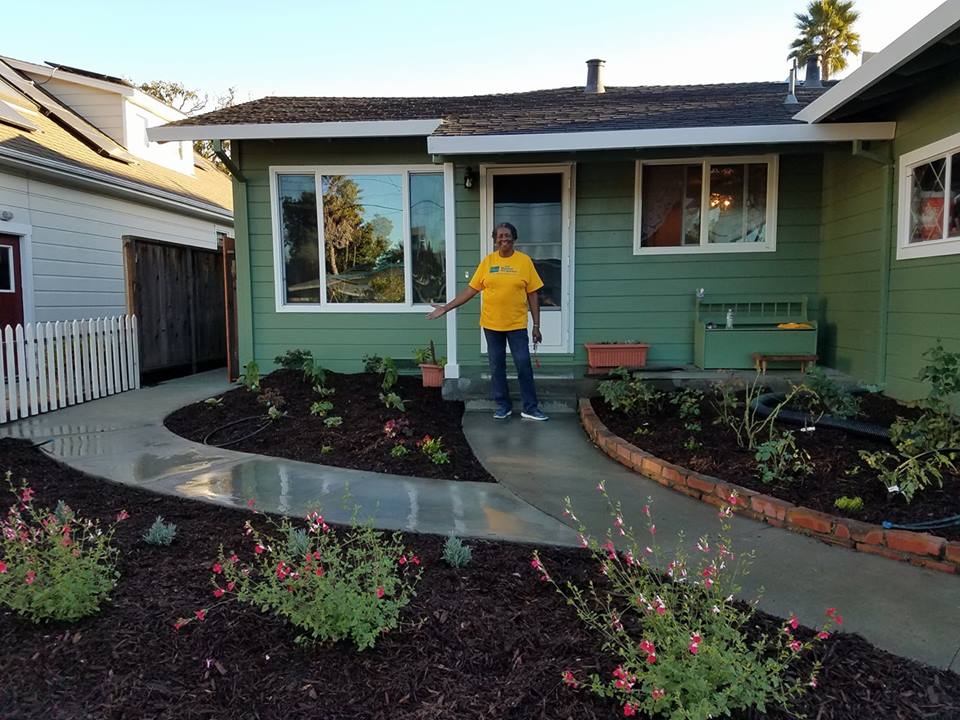This article is part of the Under the Lens series

From left, Lee Reich and her daughter Stacy Lince were paying a collective $4,000 per month to rent their separate homes in Santa Rosa, California. They pooled their resources together and purchased a home with a detached garage that they could convert into an ADU. Photo by Nicolás Boullosa via Flickr, CC BY 2.0
This is the fifth installment in ADUs Explained, an Under the Lens series.
Accessory dwelling units (ADUs) get a lot of press as a possible remedy to the nation’s missing rental housing—often promoted as “a small solution to a big problem.” And the last decade has certainly been a banner one for ADU construction—about 100,000 were built each year. Even so, as of 2021, there were just 1.4 million ADUs in the entire nation.
And while they’re credited with being “naturally affordable,” ADUs are typically built in more affluent neighborhoods and, when rented out, they command market-rate prices. ADUs are rarely affordable to very-low-income tenants—a population facing an extreme lack of housing options: The U.S. needs nearly 7 million units for renters earning 30 percent or less of their area median income.
‘Our housing stock has to be as flexible as the needs of our families … not serve a rigid ideal of a single-family nuclear box from the 1950s.’
In the last several years, more and more cities and counties nationwide have codified laws allowing homeowners to add an ADU to their house or build one on their property. But local changes haven’t increased ADU development enough to make a dent in the housing shortage, even in places that encourage ADU construction and streamline the development process. For example, in Denver, Colorado, where ADUs became legal in 2010, homeowners built an average of just 24 per year between 2010 and 2020—while the city’s population grew by 115,000.
Why the lackluster numbers? Because small-scale solutions can’t fix large-scale problems, says Denise Pinkston. She’s a veteran real estate developer who helped write the first ADU ordinance in Berkeley, California, in the 1980s. Pinkston is founder and president of The Casita Coalition, a California-based group of “like-minded professionals and policymakers” who convened to push through policy to encourage ADU development in their state—where finding affordable housing is a nightmare, especially for renters. Yet despite acceptance in many jurisdictions, persistent regulatory and financial roadblocks continue to prevent ADU development from ramping up on a large scale.
“If you take away one barrier at a time, you don’t get more housing. You may get a few more units, but if you think of zoning barriers as a brick wall, you cannot take away one brick and expect the wall to move,” Pinkston says. “And if you try to do it one city at a time, you can’t actually lower the cost [of building housing] because people don’t build in one city alone. They build all over a region or all over a portion of the United States. If you really want to . . . lower the cost of building housing, you’ve got to do it at scale.”
A few states are trying to do just that. Oregon and California legalized ADUs on most single-family lots, forcing local governments to address outdated zoning restrictions. But while popular with many residents, others don’t want the state legislature dictating what types of housing municipalities must allow. A few loud opposition groups in California are trying to overturn the state’s zoning allowances. And many housing experts wonder if increasing ADU development can bolster overall housing stock in amounts meaningful enough to drive down rents.
Statewide Reforms in California
Through several years of efforts by activists and grassroots organizations, California lawmakers passed, then modified, legislation making ADUs easier to permit and build. In 2016 and 2017, the state enacted a suite of laws legalizing ADUs on most single-family parcels as a use by right (i.e., requiring no special permitting process). In 2019, the legislature dismantled several remaining barriers to ADU construction by removing minimum lot-size standards and floor area ratios, reducing setbacks, and prohibiting requirements to replace parking lost to garage conversions. After the bill package passed in 2019, California YIMBY’s director of communications, Matthew Lewis, said the state had “effectively ended single-family zoning in California.” The 2019 changes also reduced the fees homeowners may be charged for building ADUs.
And California kept going, passing Senate Bill 9 in late 2021. This sweeping legislation further loosened ADU laws by prohibiting owner-occupancy requirements at any home with an ADU. SB 9 also preempted municipalities from mandating dedicated parking spaces for ADUs located within a half-mile of a “high-quality transit corridor” or a “major transit stop.”
Even more ambitiously, SB 9 created a path for a sizeable chunk of the state’s homeowners to subdivide and sell their property. Starting earlier this year when SB 9 took effect, many California homeowners became eligible to split their single-family parcels in two. Once divided, the property owner can either keep both lots and build on them, or sell the new one outright. Both lots can site a full-size house as well as an ADU—in some cases essentially allowing four units on land where previously only one was allowed.
“In much of California, only one kind of family can afford to live in a house, and we need to be more flexible in the current environment. Our families are blended, mended, extended—they grow, they shrink,” Pinkston says. “Our housing stock has to be as flexible as the needs of our families so that we serve the needs of our people, not serve a rigid ideal of a single-family nuclear box from the 1950s. We don’t expect people to live that way anymore and we should stop expecting our housing to house only that ideal.”
[RELATED ARTICLE: Common Ground: Smart Growth and Affordable Housing]
Studies show the state’s new zoning laws produced immense and immediate effects: In 2016, the year the laws passed, California’s largest metro areas issued permits for 654 ADUs. In 2017 that number jumped to 3,126. In 2018, the state issued 6,000 ADU permits. In 2019: 16,000.
“In Los Angeles, ADUs were accounting for 1 out of 5 building permits in the city . . . if you’re looking for evidence of how getting the rules right on ADUs makes a difference on how many are actually getting produced,” says Dan Bertolet, director of housing and urbanism at Sightline Institute. “In kind of a crazy, dramatic fashion, especially in Los Angeles, permits went up by a factor of 30 or something the first year after the bill passed.”
According to Sightline’s numbers, Los Angeles permitted between 100 and 200 ADUs per year prior to 2017, which saw 2,326 ADUs permitted in the city. It nearly doubled in 2018 to 4,171—comprising one-fifth of all permits issued in the city.
ADU advocates inspired by the initial wave of successful statewide policy changes pushed for more allowances, hopeful that individual unit production at a large enough scale could help make ADUs a viable solution to the extreme housing shortage. Eli Spevak, an affordable housing developer and ADU proponent, doesn’t think ADU units can replace large-scale multifamily developments, but says they’re “important from a policy perspective because they’re the camel’s nose under the tent of single-family zoning . . . At one point you’re allowing ADUs, at the next point you’re allowing four units on any lot.”
[RELATED ARTICLE: Tiny Houses—Not a Big Enough Solution]
Studies suggest that SB 9 could spur development of more than 700,000 new homes (not all of which would be ADUs) on 7.5 million California land parcels. While costs range widely by location and design, ADU builds in California in 2021 set homeowners back an average of $150,000. The per-unit cost for a 100-unit affordable housing complex in the state was $425,000 back in 2016. In other words, not only will the potential new units be delivered as “gentle density” through infill construction, ADUs are easier to permit, cheaper to build, and they’re allowed in more places than other forms of housing.
“To California’s credit, they really went all out on this, and it’s probably as loose as it would ever get,” says Tom De Simone, executive director of Genesis LA, a community development financial institution that supports ADU development. “I’m surprised it passed, and I’m surprised it’s survived this long.”
Will the Statewide Reforms Last?
De Simone says having a “very well-organized constituency that really supported ADUs” was key to passing California’s legislation. But the opposition was organizing too—writing letters, posting videos on social media, and holding town halls. Groups like United Neighbors, led by Marial Pavlou Kalban, who told USC Annenberg Media she fought the 2021 bill because “packing more and more people into smaller and smaller spaces is not my idea of a great solution,” weren’t successful, but they were loud and gained a lot of support. In fact, just before Gov. Gavin Newsom signed SB 9, the League of California Cities sent him a letter signed by 240-plus cities urging a veto.
SB 9 has only been in effect for a few months, and several groups are still trying to have it repealed. Much of the resistance comes from local leaders who want to find legal loopholes to avoid state preemption of local zoning laws. In Redondo Beach, the city council in December voted unanimously to file a lawsuit to block the implementation of SB 9. The cities of Carson and Torrance are also suing and plan to argue in court that the law violates the state constitution by removing local land-use control from municipalities. One civil engineer who had more than 24 clients in Bay Area cities looking to subdivide their properties complained to the state attorney general after several city governments questioned his applications.
“SB 9 is the one straw that broke the camel’s back in terms of backlash,” De Simone says. “There’s been lawsuits. There’s been challenges. There’s been politics. There’s even some on the city councils who don’t like that the state’s come in and taken their land use authority away from them and all that B.S., but it’s like, well, if you’d done your job [by enabling and encouraging affordable housing construction] they wouldn’t have had to.”
The fight kicked up by SB 9 could be headed to the ballot. An organization calling itself “Our Neighborhood Voices” is trying to get an initiative on the November 2024 ballot that would give cities the power to override state-enacted land use laws. The group calls SB 9 and SB 10 (which also took effect in 2022 and allows local governments to approve up to 10-unit multifamily developments in some single-family neighborhoods) “two damaging laws that essentially tell us to ‘sit down and shut up’ about what is happening right next door to our homes while developers demolish single-family homes and build multi-story, multi-unit projects.” The initiative, were it to pass, would allow city and county land use and zoning laws to override state law, with a few exceptions, essentially overturning the lot subdivision and statewide ADU laws enacted by SB 9.
“I’m a little nervous about how the voters will respond to it because it’s statewide,” De Simone says. “I don’t think it would pass in LA and Orange County, but Fresno and a lot of those other places are a lot more conservative, and they value their homes in single-family neighborhoods.”
Louis Mirante, legislative director for California YIMBY and a board member of The Casita Coalition, isn’t worried about the opposition’s chances of getting a bill passed. In fact, he says his organization’s polling shows they might not even be able to get enough support to get an initiative on the ballot.
“The polling is very clear that [SB 9 and 10] are popular initiatives with Californians,” Mirante says. “Politicians are doing this because they are responding to voters’ most exigent crisis, and responding forthrightly to them. And voters want that. Voters want politicians who are doing that. These are popular laws. The NIMBYs who are trying to repeal these laws . . . are the unpopular people.”
[RELATED ARTICLE: Zoning for Housing Justice]
While there’s certainly resistance in some jurisdictions, many local governments are responding positively and proactively by using the new zoning allowances to their city’s advantage. The Casita Coalition conducted monthly webinars throughout 2021 for folks in California jurisdictions who were interested in learning how to best implement the new laws in advantageous ways for their specific areas. The webinars featured planners and government officials from forward-thinking California cities that crafted interesting and innovative local ADU programs to work within the statewide law while also creating zoning regulations that worked for individual communities and resident homeowners. Pinkston says the coalition is planning to release a best-practices guide that can be used statewide.
“We’re thinking about releasing it nationwide just to show how . . . a state standard that is uniform across the entirety of the state’s geography is the baseline,” she says. “And then cities can do what they do. They’re freed up to do more innovating in the space and make it work even better.”
Jan Breidenbach, a longtime housing activist and union organizer in Los Angeles who’s now an adjunct professor at Occidental College, says much of the opposition she’s heard is NIMBY-ism camouflaged as concern that the new laws don’t specifically create new affordable housing. (The League of California Cities letter to Newsom cited failure to create affordable housing as one reason for opposing the legislation, as well.) But Breidenbach argues that from a development standpoint, it’s not economically feasible to add three individual units to a formerly single-family lot and keep those units reserved for low-income renters. Because construction and development costs are so high, deeply affordable housing can only be created through subsidies, which aren’t available with small-scale ADU production. “I don’t know how you’d make affordable housing out of three units. That’s a bureaucratic nightmare,” she says. “And we just need more housing for working people who don’t need a subsidy but still are struggling.”
ADUs are considered by advocates to be “naturally affordable housing” created via “gentle density” because they’re often cheaper to rent than traditional apartments or single-family homes. So although ADUs aren’t a solution for very-low-income renters, increased ADU production would create new housing stock—which could decrease rental rates, some speculate, if enough of them are built.
It will take time to determine if California’s new laws and the resulting surge in ADU (and single-family/duplex) construction can reduce rental prices overall, says Karen Chapple, director of the School of Cities at the University of Toronto. But the statewide law prompted cities that otherwise wouldn’t likely have done so to prioritize locality-specific ADU ordinances.
SB 9 isn’t a free-for-all. The law preempts cities and counties from disallowing parcel subdivision and ADU or duplex construction, but requires homeowners to comply with local zoning requirements for heights, lot coverages, setbacks, floor area ratios, etc. To meet the new requirements and set rules that satisfy residents and keep development in line with local comprehensive plans, many jurisdictions had to scramble to pass local ordinances with appropriate development parameters. If they didn’t, they’d have to follow the looser statewide standards.
“So they moved quickly to design ordinances for their own cities and moved them up on their priority list ahead of everything else,” Chapple says. “Wouldn’t it be something if the state of New Jersey, Maryland, Rhode Island, New York, passed a law so everybody jumped into action to fix their zoning, which is antiquated?”
Other State-Level ADU Laws
While California passed the nation’s most aggressive zoning changes meant to encourage ADU development, it wasn’t the first state to do it. Oregon was.
The Oregon State Legislature in 2017 enacted Senate Bill 1051, requiring all towns with at least 2,500 people to allow one ADU on all single-family lots. It further expanded density requirements in 2019 with a measure that made it so cities with populations of more than 10,000 must allow duplexes in areas previously zoned for single-family homes. The 2019 law also improved the efficacy of the earlier ADU law by preempting localities from instituting owner-occupancy requirements or requiring homeowners to construct off-street parking.
Washington state also got an early start on ADU legalization, in 1993 becoming the first to adopt state-level legislation that preempted local prohibitions against ADUs. The state legislature passed the Washington Housing Policy Act and began requiring cities with more than 20,000 residents, counties with more than 125,000 residents, and any counties that do their planning under the state’s Growth Management Act to create ordinances that allowed ADU construction.
Although a ‘90s trendsetter for ADU-friendly legislation, Washington legislators this year failed to pass zoning reforms like California’s and Oregon’s: HB 1782 and SB 5670 would have unlocked what state housing advocates called “missing middle” housing by allowing as many as four units on all lots zoned for single-family homes. But it didn’t pass. And in March, state senators killed House Bill 1660, which would have preempted existing local laws that block ADU construction.
A few East Coast states recently began exploring statewide ADU-friendly legislation options. New York state—which is short more than 600,000 affordable housing units—is considering a bill that would prohibit municipalities from creating onerous restrictions on homeowners looking to add an ADU to their property. Currently with the Judiciary Committee, S4547A would preempt localities from enforcing barriers like required off-street parking, excessive permitting fees, and public hearings. The bill has been winding its way through the State Senate for more than a year. If it passes, the Regional Plan Association estimates the state could add nearly 500,000 housing units to the Long Island, lower Hudson Valley, and New York City areas by 2040.
Connecticut—one of the wealthiest states in the country, and among those with the greatest income inequality—in 2021 enacted a statewide law enabling ADU construction by allowing both attached and detached units on single-family homes as a use by right.
Connecticut ADU proponents fought similar opposition from municipalities vehemently resistant to relinquishing local control to state oversight. While the bill’s passage was a win for ADU proponents, the opposition was loud enough to significantly reduce the impact of the legislation that passed: with a two-thirds majority vote from local planning commissions and legislative bodies, municipalities can either opt out entirely from allowing ADUs (called “accessory apartments” in the state) or can include minimum parking rules (which are otherwise banned by the bill).
Neighboring New Jersey is considering two proposals to legalize ADUs in the Garden State. The state senate is considering S345, which would legalize ADUs statewide. But, like Connecticut’s new law, S345 allows jurisdictions to opt out via a two-thirds majority vote by the local governing body. New Jersey Assemblywoman Britnee Timberlake recently introduced legislation that would also legalize ADUs statewide, but Timberlake’s bill doesn’t include an opt-out option.
“If you add an opt-out clause, what was the point of doing a statewide ADU [law] if the municipality can just say, ‘We’re not going to do this’? So there’s no opt-out clause. That’s what makes the bill strong and makes the bill have teeth so that the power then goes into the hands of the residents,” Timberlake says. “No longer are they restricted by the municipality that may say they’re not allowed to have the unit because of whatever ordinance has been in place for many years.”
Despite the heightened national ADU interest, support, and legislative momentum, as of 2021 just eight states had codified legislation that either allows ADUs to be built or preempts localities from banning them altogether or making it impossible to get them permitted. And existing laws vary wildly from state to state. Hawaii, for example, has allowed two dwellings, called ohana units, on single-family lots since the 1980s. Rhode Island in 2017 began allowing single-family homeowners to add an ADU by right, but only if a family member who’s at least 62 years old is going to live there.
Just as the laws vary from state to state, so do the types and levels of resistance. NIMBY opponents fear that rental units in formerly single-family neighborhoods will change the character and introduce riffraff. The pushback from residents is loud; from city-level elected officials and city planners the opposition is “almost like a religion,” Sightline’s Bertolet says. But he thinks statewide reforms could help.
“Local officials are petrified of any backlash,” he says. “Housing affordability is a regional thing, and why should one city stick its neck out to try to help by going through some brutal, controversial zoning reforms when the city next door isn’t doing anything.”
|
With the support of readers like you, Shelterforce has continued to expand the ways we break down what’s happening in the community development world. Become a supporter today and help keep us strong. |




The backlash may be delayed, but it is very, very real. Mirante’s quote…? He’s just regurgitating the kool-aide that yimbys use as mouthwash.